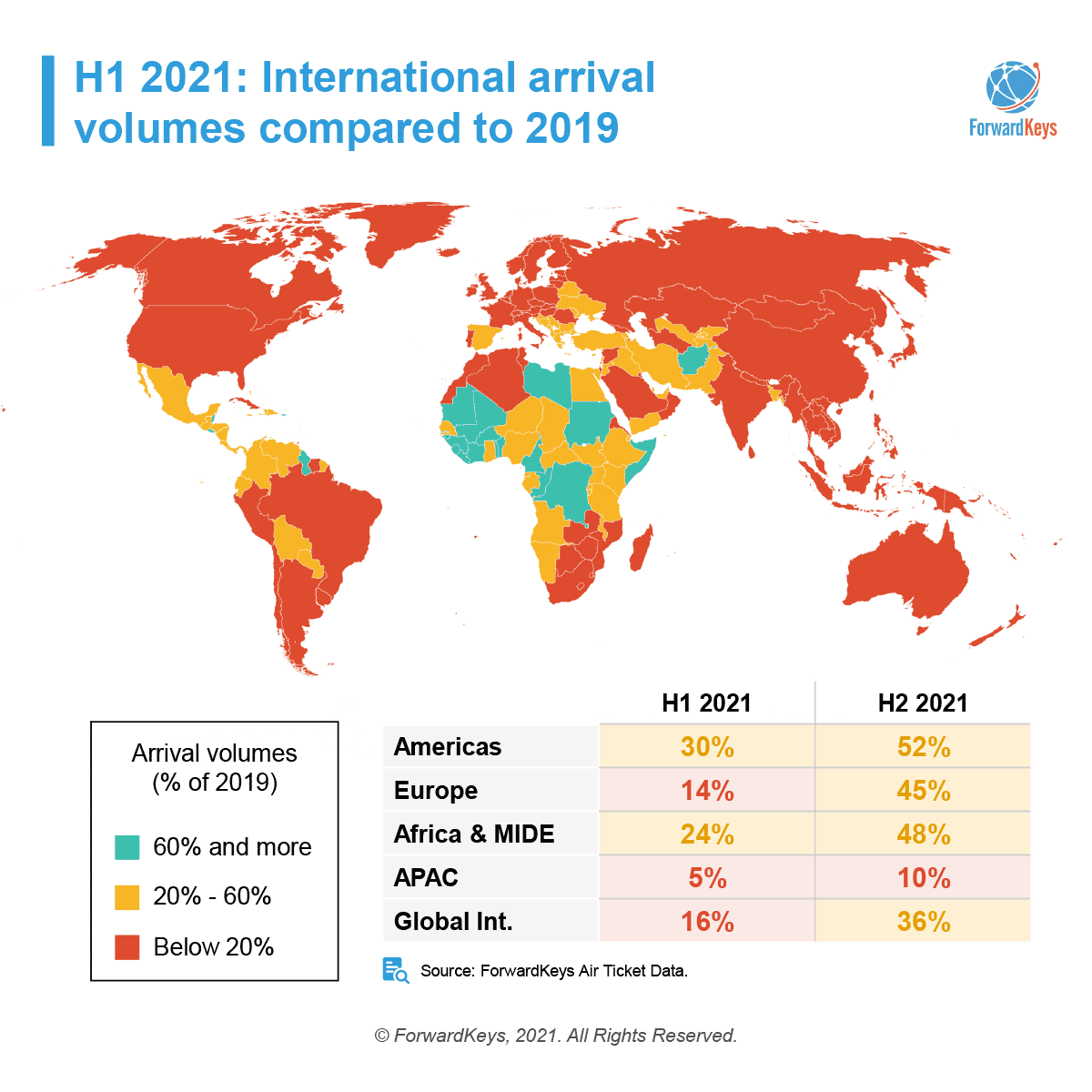US leisure travel and inter-regional tourism are ForwardKeys’ top travel trends for 2021.
For its end of year review, flights data analyst and Echolution partner, ForwardKeys has highlighted its top eight travel trends from 2021 in a year dominated by an industry waiting for recovery from the Covid-19 pandemic.
1 US leisure travel drives recovery
A comparison of the world’s top destination cities, before the pandemic in 2019, and throughout 2021, illustrates the strong trend towards leisure travel leading to the recovery, says ForwardKeys.
Several major cities have been pushed down or out of its top 20 rankings, whereas major leisure destinations, particularly for US holidaymakers, have climbed high.
While Dubai remains at the top of the list (it is a major leisure destination as well as a substantial travel and commerce hub), the most notable rises include, Miami, from 18th to 5th, Madrid from 16th to 10th and new into the list, Cancun (Mexico) at 2nd, Cairo (Egypt) at 9th, Punta Cana (Dominical Republic) at 12th, San Juan (Puerto Rico) at 13th, Lisbon at 14th, Athens at 15th, Mexico City at 16th, Palma Mallorca at 17th, and Frankfurt at 20th.
The two highest risers, Cancun, and Miami are both major leisure destinations popular with US holidaymakers. Most of the new entrants lower down the list are also leading leisure destinations, popular with European holidaymakers. Doha, which entered at 7th, has done particularly well as a hub for transiting travellers.
Major pre-pandemic destinations which have fallen out of the top 20 list include ten major cities (of which eight are in Asia): Bangkok, Tokyo, Seoul, Singapore, Hong Kong, Taipei, Shanghai, Jeddah, Los Angeles and Osaka.
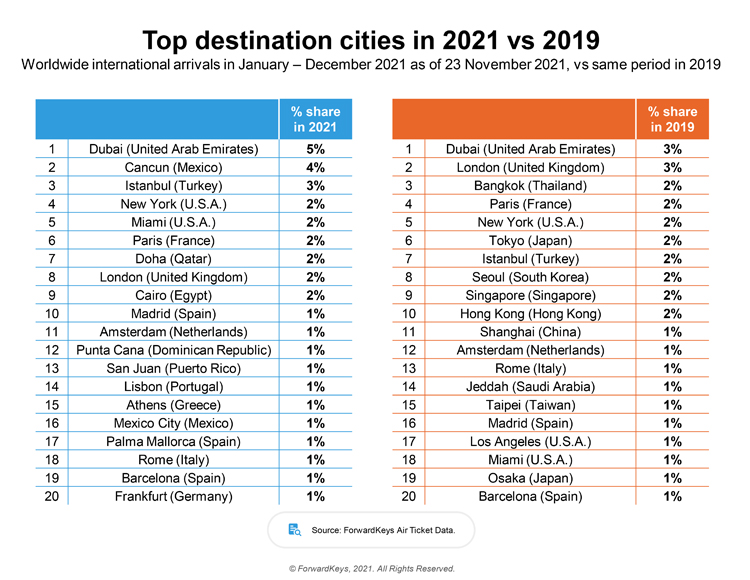
2 Americas (Central America & Caribbean) most resilient region
A review of worldwide travel in 2021, broken down by region, reveals the extent to which international travel was paralysed, according to ForwardKeys analysts.
Overall, international air travel was just over a quarter (26%) of its pre-pandemic level. The Asia Pacific region reached just 8%; whereas Europe achieved 30%, Africa & the Middle East 36% and the Americas 40%.

A comparison of travel between the first and second halves of the year (H1 and H2) shows that global international travel more than doubled from 16% of pre-pandemic levels to 36%.
In the Asia Pacific region, flight arrivals grew from 5% of their 2019 level in H1 to 10% in H2. In Europe, they grew from 14% to 45%; in the Middle East & Africa, they grew from 24% to 48% and in the Americas, from 30% to 52%.
Within the regions, some countries were much more resilient to the impact of Covid-19 on travel than others. The stand-out destinations which best maintained their visitor numbers were Central America, particularly El Salvador and Belize, and the Caribbean – all holiday hotspots for US tourists. Many of them managed to record visitation rates above 60% of 2019 levels throughout the year.
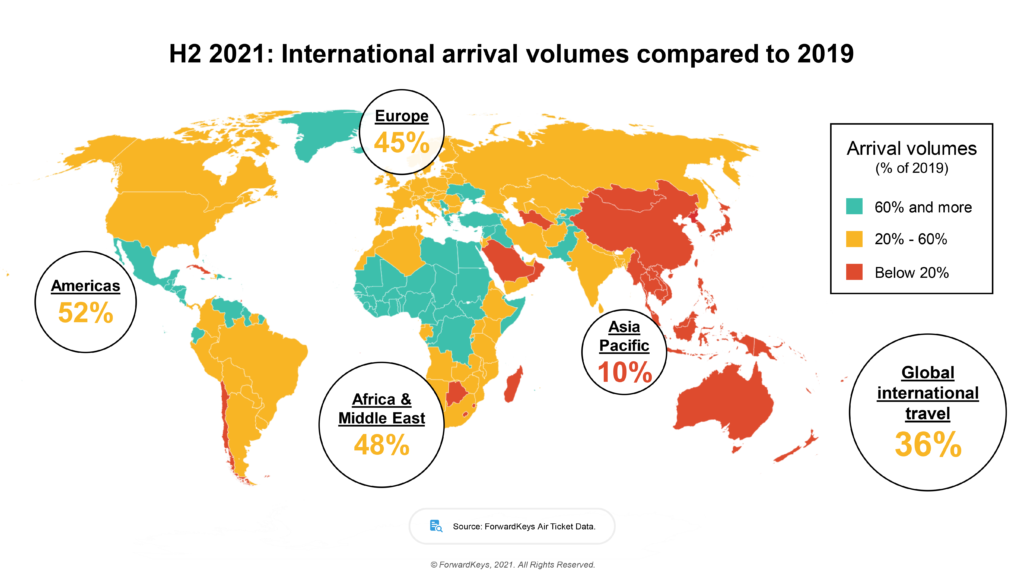
3 Middle East revives
Travel to various Middle East destinations also exceeded the 60% benchmark in H2.
Most notably, travel to Turkey climbed from 33% in H1 to 67% in H2 of pre-pandemic levels and travel to Egypt grew from 37% to 72%. Both winter sun destinations were boosted by last minute half-term bookings for UK tourists who benefitted from timely travel restrictions changes in late October.
Dubai held its position as the top city destination, (bolstered by bookings for the Dubai Expo tourism exhibition) and Doha overtook Dubai as an air transit hub.
4 Domestic travel drives recovery for large continents
While many countries have been able to impose severe restrictions on international travel, citing the need to keep their populations safe, the result has been a rise in domestic travel or ‘staycations’ instead.
There has been a relative rise in domestic travel, particularly in geographically large countries such as Brazil, China, Russia, and the US, where it is possible to fly for a few hours without crossing the border.
In China, domestic travel volumes returned to pre-pandemic levels as early as September 2020; however, they fell back in January and again in August, owing to a resurgence in cases of Covid-19.
In Brazil, Russia, the US and China, domestic travel rose respectively to 148%, 128%, 87% and 76% of pre-pandemic levels in the second half of 2021, compared to 50%, 28%, 39% and 1% for international travel.
5 European airlines struggle
Largely due to the trend towards domestic travel in large countries, airlines in those markets have managed to weather the COVID-19 storm better than carriers whose business has been more oriented towards short-haul international travel.
This is illustrated by an analysis of the top 20 airlines in 2021 compared to 2019. The major European carriers have all fallen or are out of ForwardKeys’ ranking; and they have been replaced by airlines that have substantial business in China and the US, which have been better able to maintain capacity. For example, Ryanair and EasyJet, the two largest European carriers, have fallen from 5th and 8th position respectively, to 7th and 16th. Lufthansa, British Airways and Air France, Europe’s largest legacy carriers, have fallen out of the top 20 list, as have Emirates and Air Canada. They have been replaced by Shenzhen, JetBlue, Spirit, Hainan, and Xiamen.
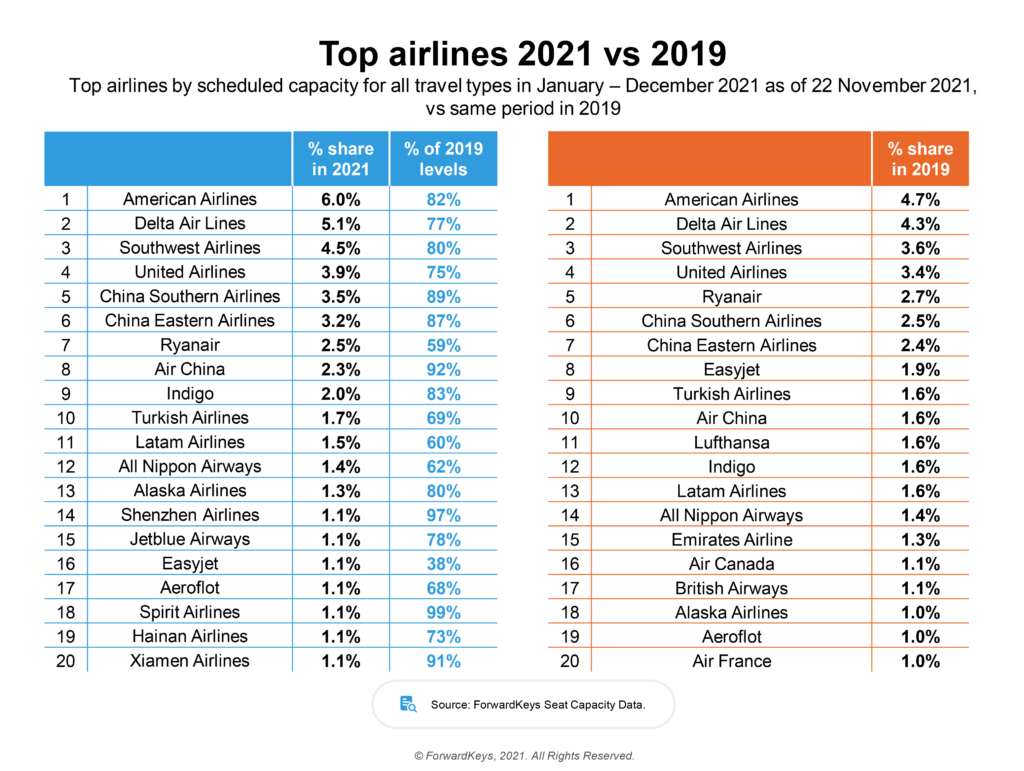
6 Decline of long-haul travel
A comparison of international travel within the major world regions, intra-regional travel, and between world regions and extra-regional (long-haul) travel, reveals that there has been a shift away from long-haul travel during the pandemic.
In 2019 the ratio of intra-regional to extra-regional travel was 56%:44%; but in 2021, that had changed to 62%:38%.
The pattern has also changed, with a greater proportion of people within Europe and the Americas travelling intra-regionally rather than the long-haul.
The trend can be explained by a combination of several factors, including the effective closure of one region of the world, Asia Pacific, the increased cost, and difficulty of travelling long-haul during the pandemic and frequently changing pandemic travel regulations, which deter people from booking long-haul travel, as it is typically booked and planned with much longer lead times.
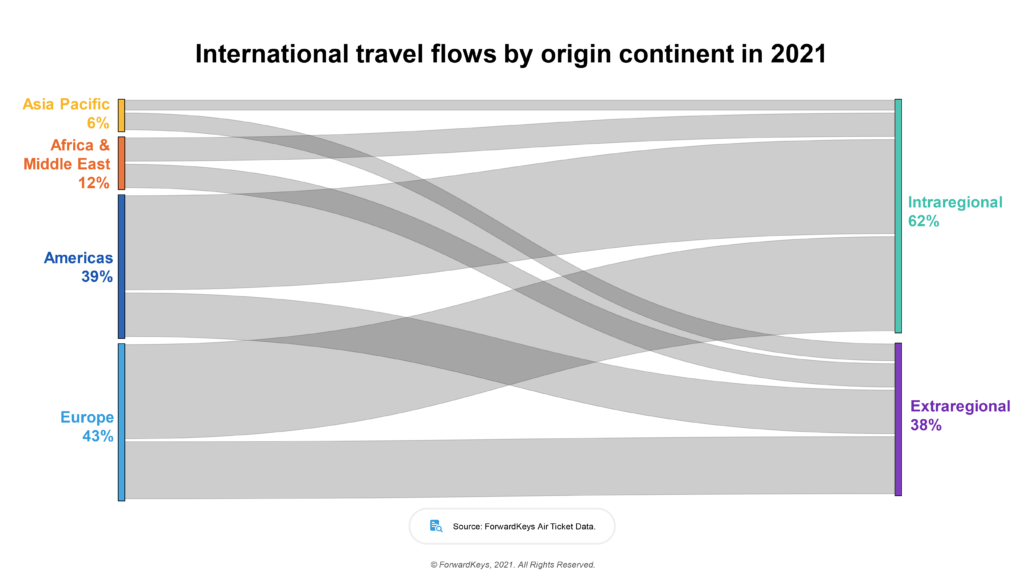
7 European and Middle East airhub rankings shift
In the battle of the airhubs, Doha overtook Dubai to become the preeminent hub airport in the Middle East, connecting air traffic between South Asia, the Middle East, North America, and Sub-Saharan Africa.
In Europe, Amsterdam closed the gap on Frankfurt for intra-European transits and connections with North America.
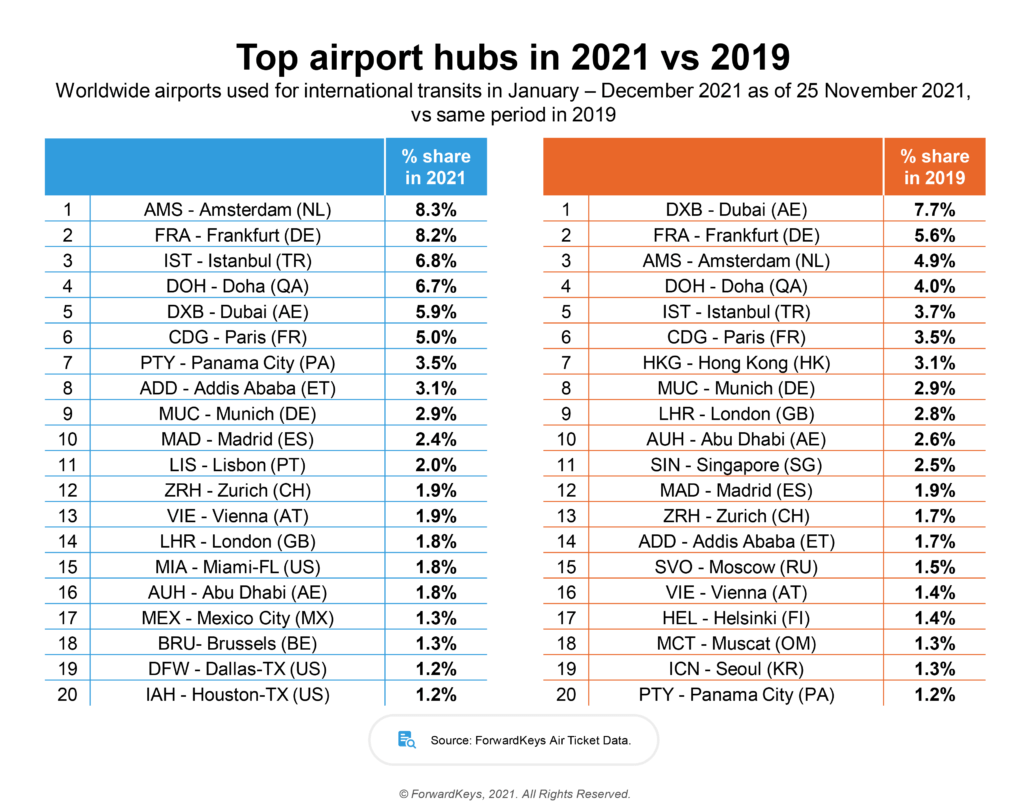
Pre-pandemic, the top ten list of global hub airports was headed by Dubai with a 7.7% market share of intercontinental flight connections. It was followed by Frankfurt, Amsterdam, Doha, Istanbul, Paris, Hong Kong, Munich, London, and Abu Dhabi.
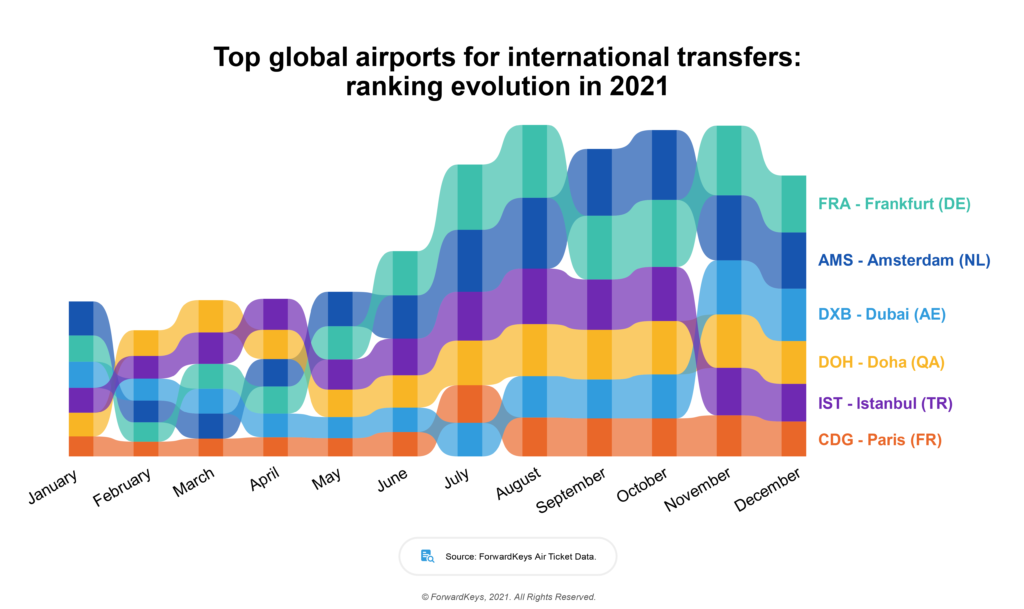
In 2021, it was headed by Amsterdam, with an 8.3% share of intercontinental flight connections. Amsterdam is now followed by Frankfurt, 8.2%, Istanbul, 6.8%, Doha, 6.7%, Dubai, 5.9%, Paris, 5.0%, Panama City, 3.5%, Addis Ababa, 3.1%, Munich, 2.9% and Madrid, 2.4%.
8 New variants threaten tourism recovery
A chart plotting the recovery in air travel shows relatively steady growth from the first quarter of 2021 when traffic was less than 20% of 2019 levels to the fourth quarter when it had climbed to over 50%.
However, there were two setbacks: the first began during the week of 12 March, when the growth in weekly bookings turned from +11% to -10%, as the Delta variant began to sweep around the world.
The second began in the last week of October when weekly bookings reached their highest point, 64% of the same week in 2019. Bookings have been slowing down ever since; and in late November, they were down to 54% of 2019 levels, which was closely correlated with a fresh rise in Covid-19 cases since late October.
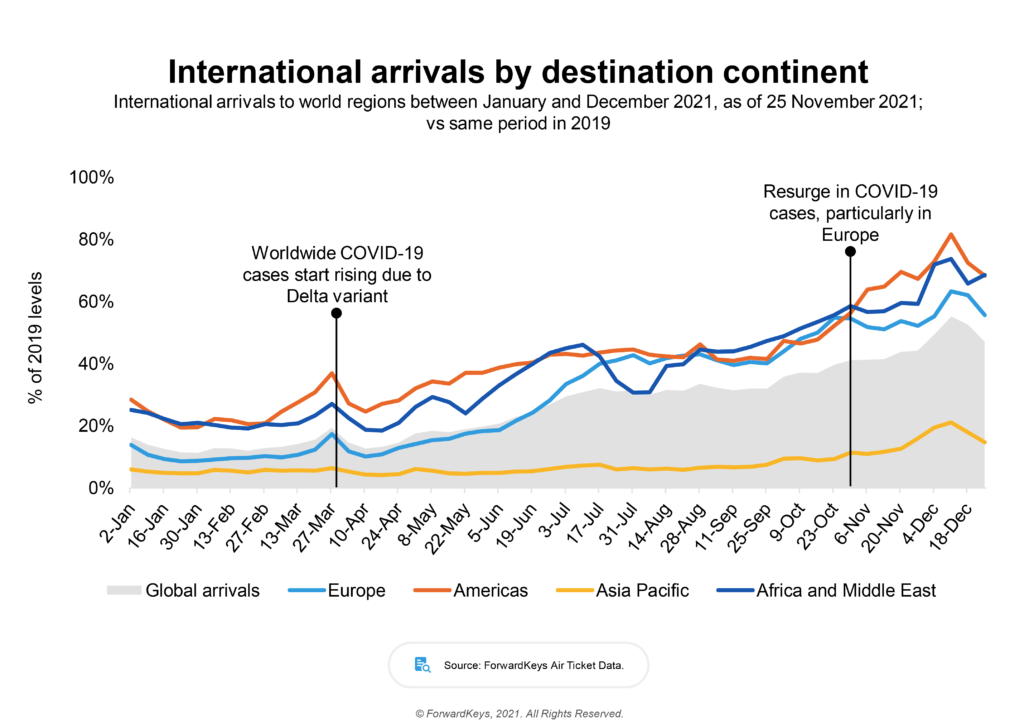
It is now likely that the emergence of the new Omicron variant, and the travel restrictions introduced in response, will inhibit demand for last-minute travel over the Christmas period.
Olivier Ponti, VP of Insights at ForwardKeys said: “2021 has been a year of travel recovery; but that recovery has been bumpy and patchy, with many established destinations displaced and several tourism-dependent destinations making valiant efforts to retain the patronage of leisure travellers.”
“It has also been a tug of war between a strong pent-up demand to travel on the one hand and travel restrictions, imposed by governments to inhibit the spread of Covid-19 on the other.”
Echolution takeouts:
With leisure travel in domestic markets, the Americas as a tourism hotspot and regional airhubs all highlighted as 2021’s key travel trends, there are demographic data trends to dive into here too.
“The Americas presents a significant opportunity for travel retail brands to target resilient domestic market travellers across the region,” says Echolution partner, Eamonn Leacy. “Regionally, the Americas has the most niche and diverse demographics data sets for profiling travellers and targeting them by destination, by spending power, by brand propensity and by travel or shopping habits.
“In addition, having the latest flights data trends to hand, showcases the opportunities to target travellers pre-trip, in transit (especially via airhubs and major leisure tourism destinations) and in market. With the rise in domestic tourism comes rich traveller behaviour insights, capturing more marketing segments for tourists in their home markets that can be personalised down to their trip itineraries and for after their return.”

